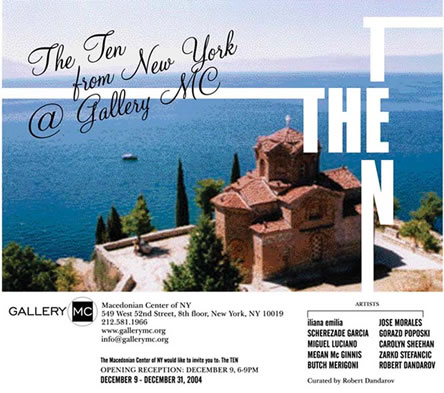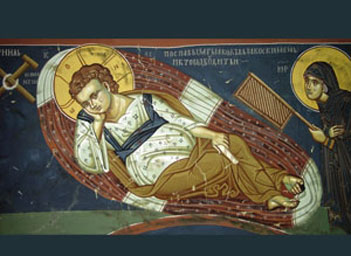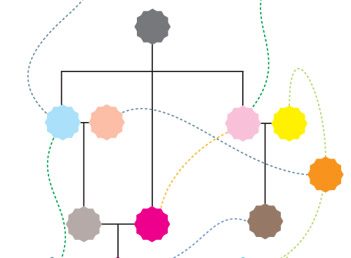THE TEN – Group exhibition
Gallery MC is pleased to announce:
THE TEN
Group exhibition
Gallery MC
549 west 52nd street 8th fl.
New York NY 10019
www.gallerymc.org
Contact Nina Manova: info@gallerymc.org
Dec.9-31 2004
OPENING RECEPTION
Dec 9, 6-9 pm
From December 9tth to December 31st Gallery MC will present THE TEN, an exhibition featuring the works by ten artists of diverse ethnic backgrounds living and working in and around the New York City area. The gallery MC is a part of the recently opened Macedonian Center in New York with a vision of creating cross-cultural dialogue between Macedonia and US as a vital step in the affirmation of the Macedonian cultural heritage worldwide.
From the catalogue introduction by Sara Hermann:
“Each one of the artists will define and describe an idea of map, an idea of the cartographies able to construct the space they dwell in.
The interaction of the elements embedded in the imagery of Carolyn Sheehan works starts with her creative process. Each piece, as an emotional snapshot of a moment in her life has evolved from direct reference to those instants to a bodily representation of accumulation and references. The focus then, shifts from the attention to the fundamental properties of the materials she employs to the process of binding them and giving it an allegorical meaning. Each one of these compositions evolves spontaneously because the unpredictable exigencies caused by the interaction of the components as well as the amalgamation with memory and immediate responses to the world the artist inhabits.
lliana Emilia approaches pertinent ideas about the extended use of the technologies and means of reproduction, the possibilities and feasibilities of reproduction, and the re-positioning the message. She blends these notions with a high emotional sense, recognizing in the banal object (a chair) a vestige or witness of a fleeting moment or a mood. The diachronic sense that exists in this parallelism of message in message, or better said, notes in message, grants diverse levels of reading, being a pertinent one intertextuality in terms quite near to the literary ones. The text that sub lies and persists beyond the writing is the evidence that is inserted blown up in amazing means in the ordinary language of home furniture. The importance is transferred then, from the writing to the implicit and from there to the dimensionality that grants a new sense to it. The text and the furniture becomes then a cry or a whisper depending on the eye of the beholder.
Gorazd Poposki delineates his territory in a radically simplified and abbreviated way. In order to create pure and resounding forms he suppresses the adornment and explicit narrative referents from his marble sculptures. But in every piece underlies the sacred and numinous sub-text in the sinuous and ethereal surfaces. With the aim of capturing the essence of his subjects, elements that are the impersonation of dreams and spiritual themes-, he renders them visible with minimal formal means. This abstract synthesis evokes the solitude and triviality of the human preoccupations with respect to the perpetuity of the universe.
Transcending prescribed categories, Robert Dandarov blur the conventional boundaries between history and metaphor through his heightened and sophisticated use of cultural references. In his pictorial work the artist has consistently expressed an interest and affinity for the lost language of symbolism. The paintings are populated by symbols of forgotten content, images with lost meanings that are reinvented by Dandarov acute perception of contemporary life. His complex vision nurtured by a past that is constantly present is translated in a ritualistic, cyclic metaphor for transformation and evolving that is never an idyllic one. These images become meditative as they evolve on themselves returning always to the original need to enunciate, to declare the presence of a past.
To Scherezade García geographical displacement gives her authority to tell stories from both ends. The tale of the voyage in recent pieces transcends the fictional anecdotic level to be transformed to a personal account of the pilgrimage that implied this relocation and the causes and effects of the facts implicated. At the same time, the situation portrayed transcends the referential ingredient of tales and told stories to be a bona fide document of the event. It is interesting to point out that the images that reproduce the voyage in her video are not presented in a manner of moral or political harangue but as a reflexive reminder of the idyllic way in which the journey is envisaged and the horrifying aspects of exile. “The fascination with the duality of things is an essential part of my speech”, Garcia states, and because of that she recounts her own history and play with symbols and constructed possible events. Butch Merigoni’s work explores the layers of meaning surrounding personal memories. The images inserted (as a pasted up recollection of places and people) seem to dominantly burst in into a pictorial space that conserves a personal historical reference to relate different persuasive stories in ways that suggest unforeseen and complex networks of meaning beyond the narratives of each element. Each component of the painting invites observation and interpretation beyond its primal image. From the silenced spaces of abstract rendering to its intertwining with the figurative idea of remembrance, a modified look to evocation is built in each of his works. Miguel Luciano explores the legacy of historic stereotypes related to immigrants, and mainly to the relations between Puerto Rico and United States. In his works he employs such characters and emblematic figures such as el sagrado niño, el diablo (character of the carnival), pig roasted that a s a mark have the inscription of the army, and the stereotypical image of pictorial flamboyances to comment on contemporary attitudes and situations. Given the potentially provocative nature of these stereotypes Luciano speaks of branding, of the labels imposed in the measurement of the foreign expectations. Notions on property, on fitting in, and an acute and caustic vision on the interrelation between the colonized and the colonization populate his works.
In ancient Chinese landscape painting the subject was not represented in its real dimension but it was reconstructed by the passing of the artist through its surroundings. Therefore, these turned out to be landscapes of the glance and were closely tied to the “being” of the creator. Zarko Stefanic presents us with a proposal of a pictorial sequence, the story of his days. But not to report the routine, with its extraordinary beings and things, but instead the imagery and situations swallowed by his cornea, heart and brain. In order to make this pictorial diary the artist reconsiders the consequences that this account could produce by itself and builds a parallel present where the visceral and cerebral visions coexist. Paul Virilio talked of the consanguinity of the images when he said that after all the images were all the same, the one we were watching and the one that pass trough our cornea and nurtured with personal experiences. The same image that sometimes becomes another is where silence exists as in a theatrical performance suggesting instants, moments that are unrepeatable.
On the other hand, Megan McGinnis explores the possibilities of representing the fragile ideas of place and memory. Parallel to that, she makes of the essential moments, -important in what they represent as social construction such as religious and pagan ceremonies of various nature- protagonists. The basic mnemonic resources with which we are equipped (the senses) add to our necessity to sweeten the memory. Those scenes of stereotypical ceremonies can evoke the ideas of loss, absence and belonging. Through these intervened images McGinnis replaces in various ways the act of assuming a person, modifying its being and finally remaking its identity by transforming its surroundings.
José Morales’ work explores personal issues such as loss, nostalgia and belonging. He uses images drawn from his personal memory, evocative images and writings, and a poetic sensibility to explore an awareness of the past. Every piece provokes self-conscious considerations of our own history and remembrance”.




